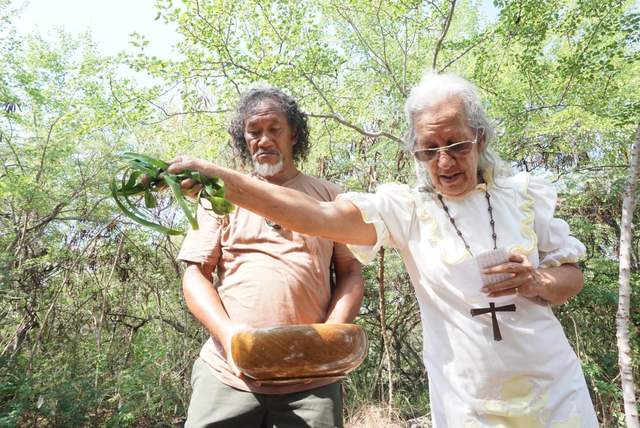HONAUNAU — A group of local families, trail builders and government officials gathered here Saturday to celebrate and bless the Kauleoli Fishing Village, which recently came into public hands as part of the Ala Kahakai National Historic Trail.
In addition to the trail segment, the 59-acre parcel, purchased from the Pace family for $3.5 million, also includes the shoreline of the Kaueleoli ahupuaa, Hawaiian house foundations, a canoe shed and salt making ponds.
Standing on the trail, Nancietta Haalilio offered a blessing for those in attendance, speaking of the ha, or breath, present in every part of nature.
“When ha is present, there is no room for animosity, vile thoughts, perverse language, you name it,” she said.
The full Ala Kahakai trail is a 175-mile stretch that runs along the shoreline from ‘Upolu Point down the Kona Coast and around South Point before ending at the eastern edge of Hawaii Volcanoes National Park.
The trail links four units of the National Park Service as well as numerous culturally and historically significant sites.
About 50 percent of the land that Ala Kahakai traverses is private land, not public, said Ala Kahakai Superintendent Arik Arakaki.
The congressional legislation that created Ala Kahakai authorized the purchase of private land from willing sellers.
The purchase of Kauleoli Fishing Village, a 59-acre parcel, was the first of such purchases.
The Trail purchased the land with funding from the Water &Land Conservation Fund via the National Rivers and Trails Inititiative.
The village is located just south of Puuhonua o Honaunau National Historical Park, which will allow the part of the trail in that park to connect with the stretch of trail in the fishing village.
Haalilio also brought up the importance of preserving Ala Kahakai, saying that while it might be considered a trail today, historically it was more than that.
“Back then it was the road,” she said. “The (missionary) Rev. William B. Ellis walked this road and was instrumental in documenting history, cultural history in all the village communities that he passed through.”
She also spoke about running along parts of the trail as a child, referring to “precious, precious times” and the connected relationships people had back then.
Ala Kehakai, she said, is an opportunity to renew those relationships.
“We are not disconnected by the geography. We are now connected because the road is going to be open for its use,” she said.
Arakaki said he wants the trail to be seen like the Camino de Santiago in Europe or the trail to the top of Mt. Fuji in Japan.
Those trails, Arakaki said, are revered as sacred trails. Ala Kahakai, he said, is similar, saying the trail here is “sacred ground.”
“People need to know as they come through this place: it’s about being reverent,” he said.
Analu Silva, who has been doing trail clearing and traditional masonry on the trail, said he wants present and future generations to “enjoy what Hawaiian ancestors have given us.”
Arakaki said more clearing still needs to be done before this segment of the trail can fully open to the public.
The trail portion in Puuhonua o Honaunau, he noted, is currently open.
Efforts to make the trail fully open to the public will also involve individual management plans for the various segments of the trail.
Arakaki said the Park Service plans to work with the individual communities along the trail to develop those plans, being sure to take into consideration their needs and desires for how the trail will be managed.
“It’s really about perpetuating a culture around the trail,” he said.






